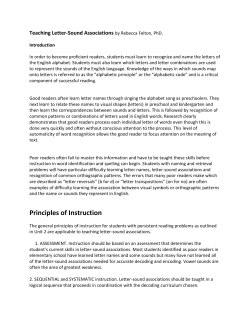
Baby Talk: Nonverbal Infant Communication Robert T. Muller, Ph.D.
Baby Talk: Nonverbal Infant Communication Learning how to understand your baby without words Published on November 22, 2013 by Robert T. Muller, Ph.D. in Talking About Trauma http://www.psychologytoday.com/blog/talking-about-trauma/201311/baby-talk-nonverbal-infantcommunication It would be hard to imagine living in a world in which you couldn’t use language to communicate basic wants and desires to others. And yet, babies very much find themselves in that position prior to acquiring verbal skills. Babies actively communicate. But they must use nonverbal cues to interact with caregivers. How these cues are read by caregivers is an integral part of the all-important attachment relationship and infant development. Elisabeth Robson, a Family and Child Therapist who specializes in infant, child, and family treatments, implements “Baby Cues” into her work with parents. “Baby Cues: A Child’s First Language” is a child development program designed through NCAST (Nursing Child Assessment Satellite Training) to help parents/caregivers respond and interact more sensitively with their babies. “Baby Cues” is based on research done by nursing professor, Dr. Kathryn Barnard, founder of the Center on Infant Mental Health and Development at the University of Washington. Robson states that knowing how to read nonverbal cues is essential because “infants, toddlers, and even young children who are developing language, but still cannot express their feelings, needs, or wants the way we as adults can, use nonverbal communication to be understood.” Because infants do not have verbal skills, nonverbal cues are all they have to communicate during that early period of their development. According to Barnard, there are two types of nonverbal cues used by infants and toddlers: engagement and disengagement cues. When a child expresses herself using engagement cues, a parent may find it a good time for talking, teaching, playing, or feeding the child. In other words, the child is willing to interact with the parent. However, when displaying disengagement cues, the child usually tries to communicate a need for a break in whatever they are doing (whether it’s eating, playing, or listening). Each type of cue may be expressed in either a subtle or potent manner. Potent engagement cues include smiling, babbling, and reaching towardcaregiver. Subtle engagement cues are more difficult to notice and may include brow raising, eyes wide and bright, facial brightening, and open hands. Disengagement cues, which are also expressed subtly and potently, occur more frequently. While potent disengagement cues are quite clear and include crawling away, crying, or falling asleep, subtle disengagement cues may provide a greater challenge for caregivers. They are often difficult to detect and include things such as fast breathing, hand behind head, hand to ear, leg kicking, and lip compression. Robson explains, “some of the cues are more subtle and may seem arbitrary and that’s why parents sometimes miss them.” In considering the relationship between the cues and parent-child interaction, Robson suggests that “noticing baby cues is very important for attachment.” It contributes to an environment in which the child feels safe and secure, and also to the development of a realization that they’re being taken care of and being understood. We see that constant failures to read the infants’ cues have direct impact on attachment. Robson adds that “we all need to disengage from things, and the idea of disengagement is not that they are having a bad experience with what they’re doing, it just means that they need a change or want to do something different.” According to Barnard, since infants can only take in a certain amount of information before needing a break from the interaction, caregivers who allow the infant to pause and then wait until the infant is ready to become engaged again, have longer and more attuned interactions with the infant. So, what happens to the relationship between parent and child if the parent cannot read disengagement cues? Robson states that when parents repeatedly miss their children’s cues, this may lead to “distress” or “the child may learn that the parent can’t read their cues and they need to try a different strategy. In extreme cases, the child may even give up and stop trying.” However, Robson notes reassuringly, “kids are very resilient and will try for a very long time to have their needs identified. If it’s a subtle disengagement cue the parent is missing, the child is going to move on to a more potent cue that, hopefully, the parent will pick up on.” A common reason why parents may miss their infant’s cues is attributed to parental trauma. Robson suggests that a parent who experienced trauma is constantly on the lookout for danger, so their efforts are directed at keeping them and their children safe. That sometimes may get in the way of seeing what’s in front of them, so they miss subtle things with their baby because they’re constantly looking at their environment. In a study by professors Karen Appleyard (Duke University) and Joy Osofsky (Louisiana State), following trauma, parents may often become overwhelmed by anxiety and experience symptoms of depression. These two factors may greatly affect their parenting and the connection they form with their children. Robson believes that an emphasis on nonverbal communication should be an integral part of the therapeutic intervention offered to struggling parents. It is helpful when parents become aware of the positive things that they do and how well they are able read their babies’ cues once they do notice. Robson adds that helping parents develop insight as to what their child might be thinking and feeling, so that they begin to think of their child as a separate person who needs things from them, has provided encouraging results. Overall, we can remain optimistic about parents’ ability to improve the interaction with their children even when they previously haven’t had that much success in reading non-verbal cues. Since relationships are not static, such difficulties are repairable, especially with young children. Robson states that “if a parent becomes more attuned to what the child needs, it has a positive effect on the relationship, and when that becomes consistent over time, there is a positive effect on attachment.” —Contributing Writer: Noam Bin-Noon, The Trauma & Mental Health Report —Chief Editor: Robert T. Muller, The Trauma & Mental Health Report Copyright Robert T. Muller
© Copyright 2025




















